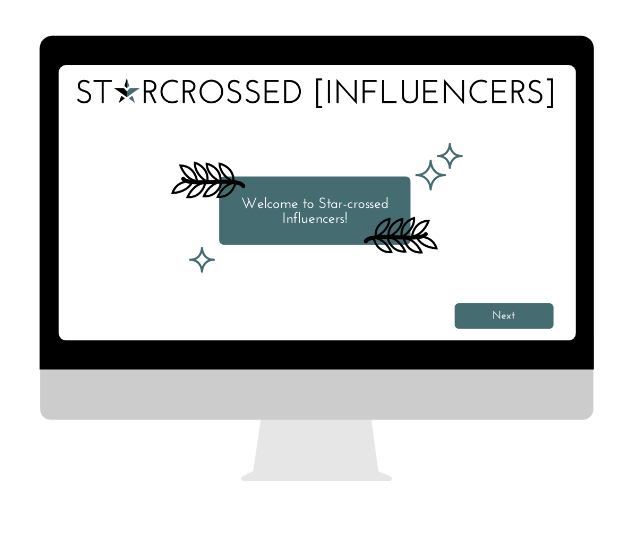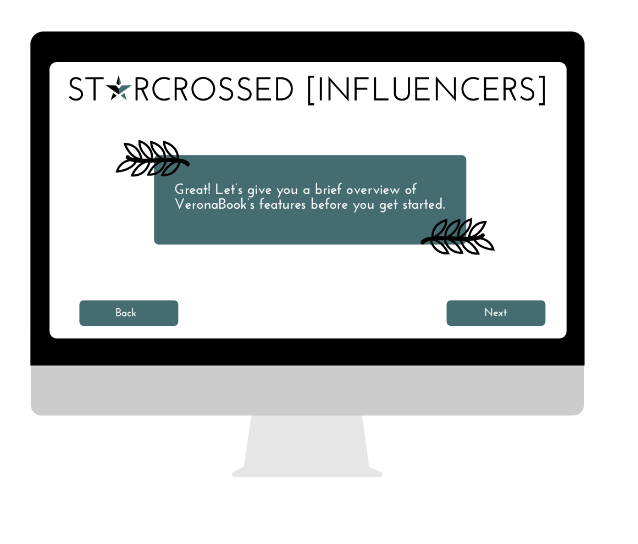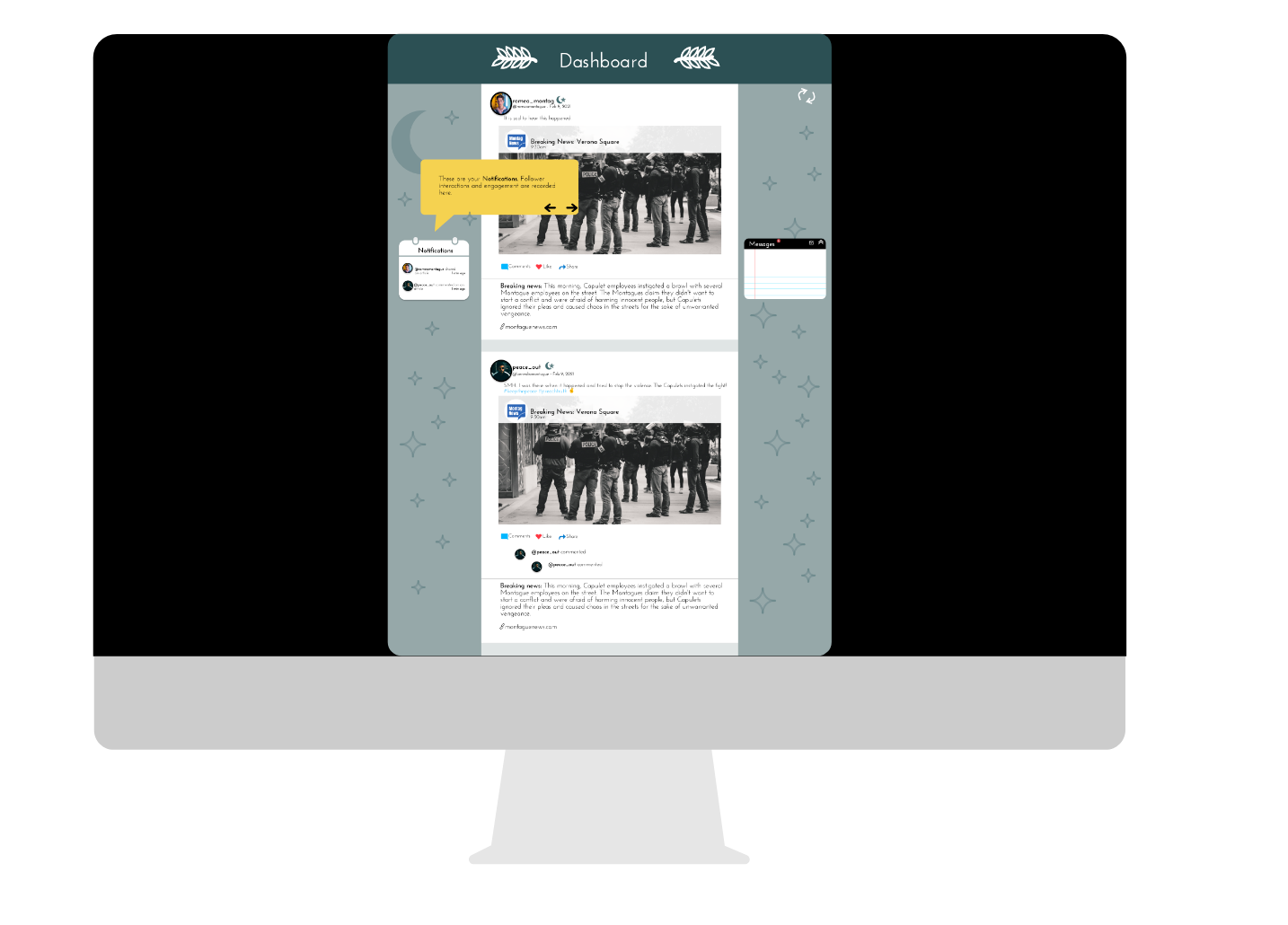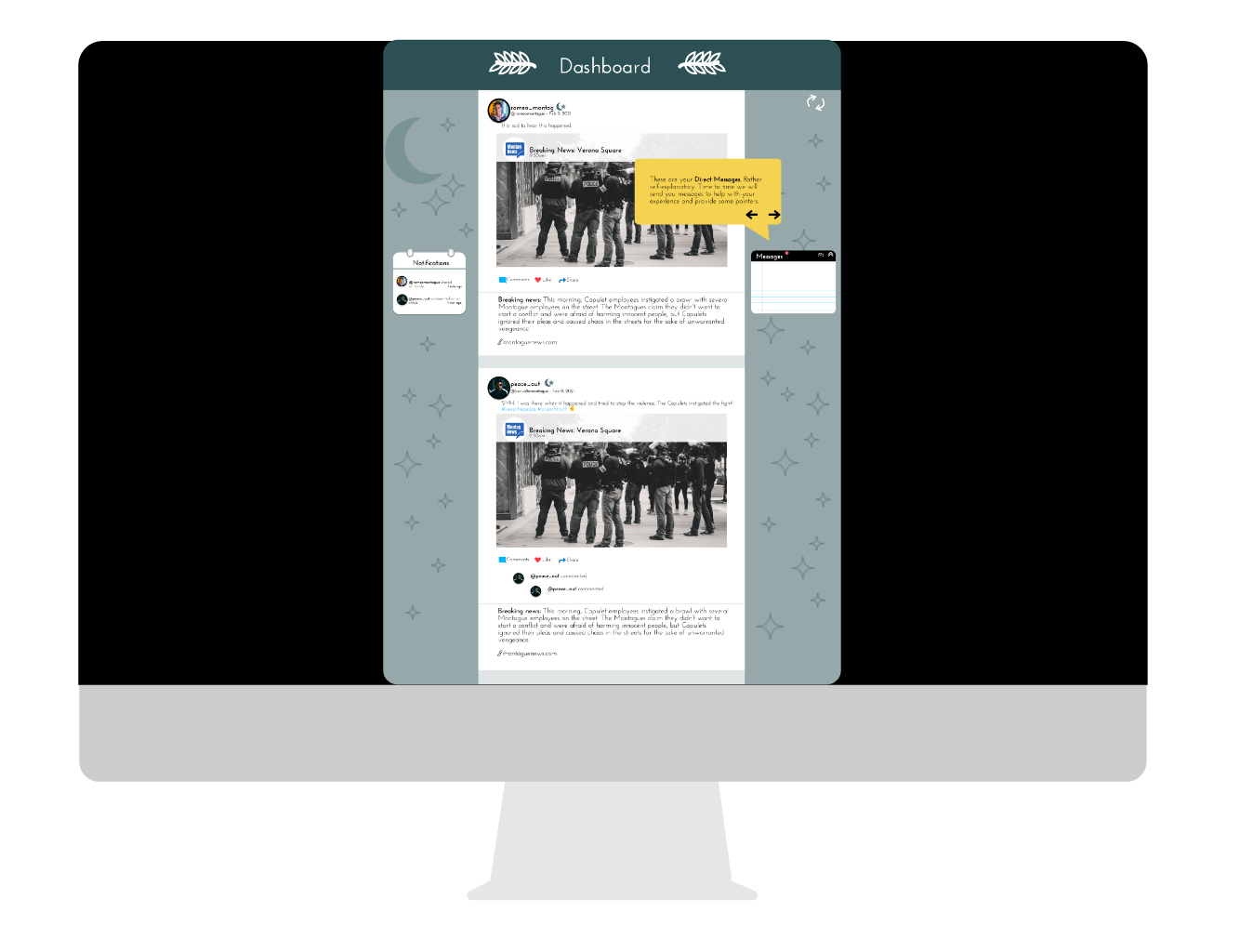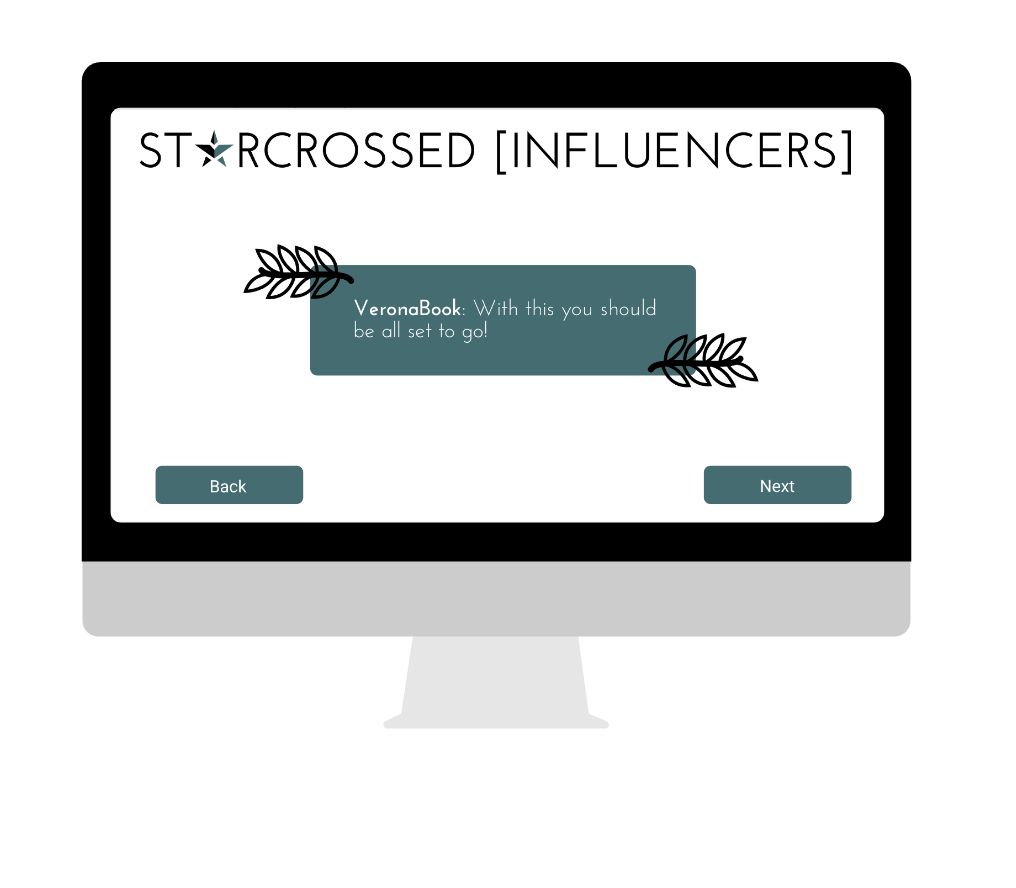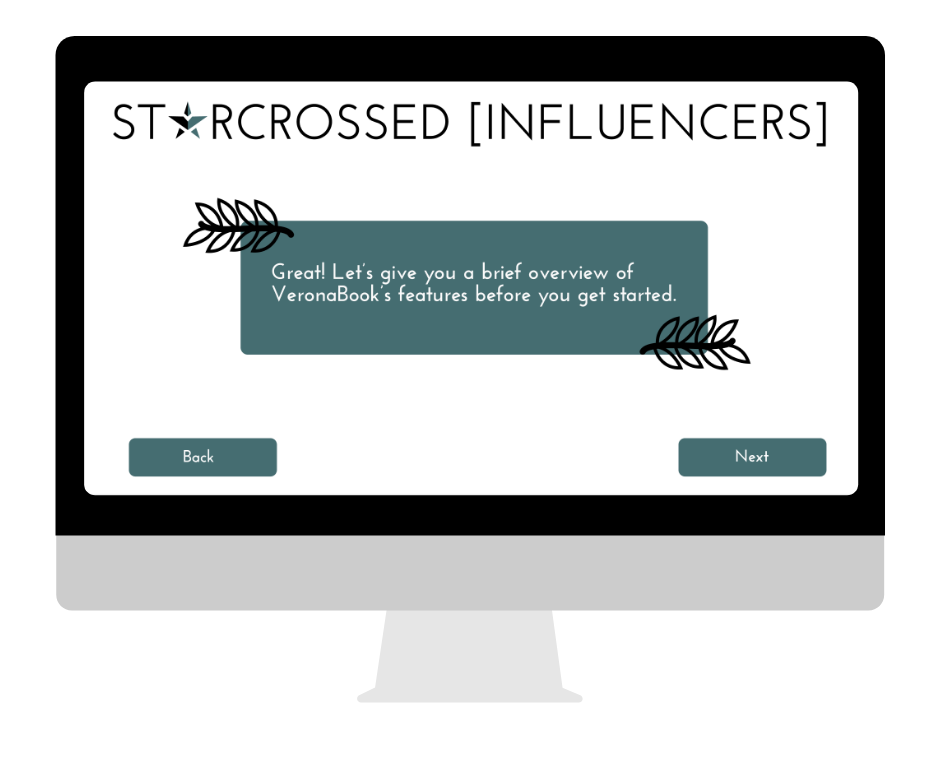Starcrossed Influencers
A game experience that raises awareness on misinformation.
Role
UX/UI Designer & Researcher
Starcrossed [Influencers] is a web-browser game experience that raises awareness for impressionable teens and teaches them skills to accurately pinpoint patterns and techniques commonly used in social media and articles that mislead people. The overall goal was to make an experience that interweaves an engaging narrative consisting of a reimagined story of the classic Shakespeare play “Romeo & Juliet.” As well as to integrate it with interactive gameplay that would help encourage our target audience to reduce the spread of misinformation and be aware of how they can be susceptible to it.
Design Challenge
The spread of misinformation is a vast and reoccurring problem nowadays in our society, especially now that a majority of people get new information from social media. Despite there being an increasing awareness to consistently “check sources,” — the point of confusion is how exactly a person can tell if a source or claim is legitimate?
Understanding our Audience
Before our team began conducting research, we first conducted surveys and analysis on gathering an overview of what the audience and focus of our project will be within the framework of misinformation.
Through research and official surveys, our team found that a sizable portion of people do not consistently know how to detect if a source is false or misleading. It is also generally seen as a grueling task to learn. Teens are primarily only learning old-fashioned fact-checking techniques from high schools, such as not using Wikipedia and noting whether or not a URL has “.org.” Today it is not considered a reliable form of fact-checking due to the general public being able to purchase those types of domain names. In our survey, it was evident that those who do check sources thoroughly typically do so for essay writing and are practiced often at the college level. We also found that the likelihood that a person would check a source is around fifty-fifty and that 73% of people get their news information from social media.
There was also some indication of bias from our survey, with around 50% of people from our survey saying they may or may not believe a claim if it came from a friend or family members. About 22% of people said they are very likely or almost always believe a claim if it came from their friends/family members. These results may be a point of concern, considering that most people get their information on social media in which friends and family members typically circulate the content.
Research Question
How do we intertwine an engaging narrative with education about an objectively dry subject such as combating misinformation on social media?
Research
One of the questions asked in our survey (November 30, 2020)
Through our competitive analysis, we found that a majority of award-winning misinformation games currently in the market do not have a richly developed narrative or plot in their games, which we suspect could be why a majority of their target audience does not play or know about these games.
After discussing with several of our domain experts (such as a high school teacher, a game developer, and an educator), we determined that the best way to get information received by younger people is to appeal to their empathy. Developing a narrative where the player can see that their actions of spreading (or tempering) misinformation based on the posts they decide to share and how it directly affects the lives of the game characters may be the best way to do that.
Goals
We aim to achieve the impact for young people to be inspired to think more critically, engage more responsibly on social media, and reduce instances of spreading misinformation.
Audience
Our main target audiences are teens (13-17), with young adults (18-25) being secondary. This decision was based on the potential for long-term societal impact, and that younger audiences are more open and easy with changing their habits compared to an older demographic.
Primary
Jax Adams (The Bored Teen) is our primary persona. She was inspired by Jody’s 15-year-old sister and the cumulative interests she has with her friends that are of the same age. Their interests regarding humor, games, and their general behaviors and knowledge regarding misinformation dictated a lot of our design decisions.
User Scenarios
“As a high school student, I want to learn what kind of information is credible through a fun interactive experience, so I can get a good grade on my homework.”
“As a teenager, I want to be able to share something funny on my social media where my friends can see so we can bond over it.”
“As a social media user, I want to be able to post content without worrying about whether or not I will be canceled or criticized for spreading misinformation.”
Secondary
Our secondary persona is Bryan Bim (The Skeptical Gen Z). Our design assumptions led us to believe that young adults around our age are fairly impressionable and open to behavioral change, which is why we ranked them as secondary. Due to the fact that college generally teaches their students how to think critically about sources and claims, they might not have as much of a need to play the game itself. However, they may still learn from the social-media-oriented advice.
User Scenarios
“As a College student, I want to find credible information on the web without any tricks so that I can find good sources to use on my research papers.”
“As a Gamer, I want to have fun and be able to relinquish my competitive side so I can focus more on my homework.”
“As a researcher, I want to know what makes these sources credible so that I know which information I can base my hypotheses with.”
Storyboard
Our storyboard features persona Jax Adams. The scenario begins with her friend sending her a link to our game, wanting to discuss what ending she’s gotten. After playing herself, she is inspired by the narrative to apply the fact-checking techniques and lessons she learned in real situations and share the game with others.
The storyboard explores how we envision our game being shared and inspiring engagement and potentially behavioral change through empathy and the discussion of misinformation issues.
Usability Testing
Currently conducting usability testing results coming soon.
Currently conducting usability testing results coming soon.
Currently conducting usability testing results coming soon.
Recommendation
Tutorial User Flow
The user flow layout of the introduction is part one of the Figma prototype.
Morning Brawl User Flow
It is the user flow layout of part two and part three of the Figma prototype.
Figma User Flow
The detailed user flows were created to explain the process of the gameplay demo from beginning to end. The purpose and overall goal for each element within the gameplay are clearly defined as well.
The user flow is split into three “parts”: the “introduction & tutorial” section, the “news article comparison” section, and the “story-driven” section. By approaching the experience this way, users can run through snippets of what a completed game would have been like, which would have been a mix of both gameplay (revolving around identifying misinformation) and its overarching story elements.
Game Logo, Layout and Title Design
The inspiration of the game logo, layout, and title design, was primarily on the game narrative, the tale of Romeo and Juliet, and our title for the game. The direction we took with the logo and title design was a retro and vintage theme that would showcase the game narrative in a fun and immersive experience.
Round 1
Round 2
Round 3
Design Layout
Initial Design Layout
Current Game Design Layout
Figma Prototype
During the design process of our Figma prototype, we decided to have the theme of the game narrative to be present throughout the game experience. Thus, we integrated moons, stars, and a vibrant night theme based on the night scene from the Romeo & Juliet play.
Coded Prototype
Coming soon.
Reflection
Coming soon.















